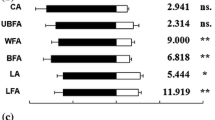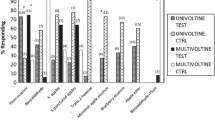Abstract
The braconid Dendrosoter protuberans and the pteromalid Cheiropachus quadrum are two parasitoids of the olive bark beetle, Phloeotribus scarabaeoides. Several chemicals such as α-pinene, β-pinene, 2-decanone, 2-nonanone, decanal, undecanal, and n-butyl acetate have been identified as attractants in the laboratory for this scolytid. Under red light at 27°C in a laboratory olfactometer both parasitoids oriented positively to both enantiomers of α-pinene, and females also responded to 2-decanone. Significant responses did not occur under white light or at lower temperatures. These results suggest that α-pinene and 2-decanone could be involved in the location of P. scarabaeoides by its parasitoids. Consequently an attracticidal control tactic for this scolytid that included these chemicals could eliminate part of the parasitoid population. In an integrated pest management program, this problem should be considered.
Similar content being viewed by others
REFERENCES
Bakke, A., and Kvamme, T. 1978. Kairomone response by the predators Thanasimus formicarius and Thanasimus rufipes to the synthetic pheromone of Ips typographus. Nor. J. Entomol. 25:41–43.
Borden, J. H. 1974. Aggregation pheromones in the Scolytidae, pp. 135-160, in M. C. Birch (ed.). Pheromones. North Holland Pub. Co., Amsterdam.
Bowers, W. W., and Borden, J. H. 1992. Attraction of Lasconotus inticatus Kraus. (Coleoptera: Colydiidae) to the aggregation pheromone of the four-eyed spruce bark beetle, Polygraphus rufipennis (Kirby) (Coleoptera: Scolytidae). Can. Entomol. 124:1–5.
Camors, F. B., and Payne, T. L. 1972. Resistance of Heydenia unica (Hymenoptera: Pteromalidae) to Dendroctonus frontalis (Coleoptera: Scolytidae) pheromones and a host tree terpene. Ann. Entomol. Soc. Am. 65:31–33.
Campos, M., and Lozano, C. 1994. Observations on the reproductive biology of two parasites of Hylesinu varius and Phloeotribus scarabaeoides (Col: Scolytidae): Cheiropachus quadrum (Hym: Pteromalidae) and Dendrosoter protuberans (Hym: Braconidae). Entomophaga 39:51–59.
ChÉnier, J. V. R., and PhilogÉne, B. J. R. 1989. Field responses of certain forest coleoptera to conifer monoterpenes and ethanol. J. Chem. Ecol. 15:1729–1745.
Dixon, W. N., and Payne, T. L. 1980. Attraction of entomophagous and associate insects of the Southern pine beetle to beetle-and host tree-produced volatiles. J. Ga. Entomol. Soc. 15:378–389.
Fukushima, J., and Kuwahara, Y. 1989. Isolation and identification of a kairomone responsible for the stinging behavior of Bracon hebetor Say (Hym: Braconidae) from frass of the almond moth Cadra cautella Walker. Agric. Biol. Chem. 53:3057–3059.
GonzÁlez, R., and Campos, M. 1990. Rearing of Cheiropachus quadrum under standard laboratory conditions. Redia 73:495–505.
GrÉgorie, J. C., Couillien, D., Drumont, A., Meyer, H., and Francke, W. 1992. Semiochemicals and the management of Rhyzophagus grandis Gyll. (Col., Rhizophagidae) for the biocontrol of Dendroctonus micans Kung (Col., Scolytidae). J. Appl. Entomol. 114:110–112.
Herald, F., Keller, M. A., Lewis, W. J., and Tumlinson, J. H. 1988. Beneficial arthropod behavior mediated by airbone semiochemicals. IV. Influence on host diet on host-oriented flight chamber responses of Microplitis demolitor Wilkinson. J. Chem. Ecol. 14:1597–1606.
Kennedy, B. H. 1979. The effect of multilure on parasites of the European elm bark beetle, Scolytus multistriatus. Bull. Entomol. Soc. Am. 25:116–118.
Landolt, P. J., and Phillips, T. W. 1997. Host plant influences on sex pheromone behavior of phytophagous insects. Annu. Rev. Entomol. 42:371–391.
Lanier, G. N., Birch, M. C., Schmitz, R. F., and Furniss, M. M. 1972. Pheromones of Ips pini (Coleoptera: Scolytidae): Variation in response among tree populations. Can. Entomol. 104:1917–1923.
Martin andrÉs, A., and Luna del castillo, J. D. 1990. Bioestad´ý stica para las Ciencias de la Salud. Ed. Norma, Madrid, 622 pp.
Pettit, F. L., Turlings, T. C. J., and Wolf, S. P. 1992. Adult experience modifies attraction of the leafminer parasitoid Opius dissitus (Hym: Braconidae) to volatile semiochemicals. J. Insect Behav. 5:623–634.
Rice, R. E. 1969. Response of some predators and parasites of Ips confusus to olfactory attractants. Contrib. Boyce Thompson Inst. 24:189–194.
Rodriguez, M., Plaza, M. T., Izquierdo, I., PeÑa, A., Campos, M., and Lozano, C. 1996. Estudio de los mediadores químicos del barrenillo del olivo Phloeotribus scarabaeoides Bern. (Coleoptera: Scolytidae). Actas de la 26 Reunión Bienal de la RSE de Química, Vol. II, pp. 1005–1006.
Schlyter, F., and LÖfqvist, J. 1986. Response of walking spruce bark beetle Ips typographus to pheromone produced in different attack phases. Entomol. Exp. Appl. 41:219–230.
Sullivan, B. T., Berisford, C. W., and Dalusky, M. J. 1997. Field response of Southern pine beetle parasitoids to some natural attractants. J. Chem. Ecol. 23:837–856.
Szauman-szumski, K. J., PeÑa, A., Kelly, D. R., and Campos, M. 1998. Identification of chemicals attractive to the olive bark beetle Phloeotribus scarabaeoides Bern. in laboratory bioassays. Biocontrol 43:345–355.
Tamayo, J. A. 1998. Análisis y determinación de posibles semioquímicos del barrenillo del olivo (Phloeotribus scarabaeoides). BSc. Universidad de Granada, Granada, Spain.
Vet, L. E. M., WÄckers, F. L., and Dicke, M. 1992. How to hunt for hiding host: The reliability-detectability problem in foraging parasitoids. Neth. J. Zool. 41:202–213.
VitÉ, J. P., and Williamson, D. L. 1970. Thanasimus dubius: Prey perception. J. Insect Physiol. 16:233–239.
Wood, D. L., Browne, L. E., Bedard, W. D., Tilden, P. E., Silverstein, R. M., and Rodin, J. C. 1968. Response of Ips confusus to synthetic sex pheromones in nature. Science 159:1373–1374.
Author information
Authors and Affiliations
Rights and permissions
About this article
Cite this article
Lozano, C., Gonzalez, E., Peña, A. et al. Response of Parasitoids Dendrosoter protuberans and Cheiropachus quadrum to Attractants of Phloeotribus scarabaeoides in an Olfactometer. J Chem Ecol 26, 791–799 (2000). https://doi.org/10.1023/A:1005492608748
Issue Date:
DOI: https://doi.org/10.1023/A:1005492608748




